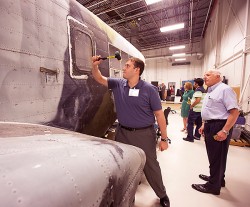More than 150 people showed up Aug. 14 for the grand opening of the School of Engineering’s new Laboratory for Systems Integrity and Reliability (LASIR).
The visitors to the spacious, 20,00-square-foot facility were dwarfed by the airframe of the military heavy-lift helicopter, the Humvee sitting on a four-foot platform where large hydraulic pistons under its front wheels caused it to jump every few minutes and the house-sized wind-tunnel designed to test wind turbines.
“This fantastic new facility really changes and revolutionizes Vanderbilt in many ways,” said Engineering Dean Philippe Fauchet at the brief presentation. “For some time, Vanderbilt has been known for the quality of its theoretical and modeling work. But, when you come up with a theory or you create a small model, you don’t really know how it works in the real world. [rquote]This laboratory gives us the ability to validate our theories and models. This has been the missing link.”[/rquote]
In his remarks the lab’s director, Doug Adams, emphasized that the laboratory is interdisciplinary in nature and is available for the entire engineering faculty. The chair of Civil and Environmental Engineering and Distinguished Professor of Civil Engineering reported that he has already established research collaborations with Eric Barth, associate professor of mechanical engineering, Gabor Karsai, professor of electrical and computer engineering and computer science, Sandra Rosenthal, director of the Vanderbilt Institute for Nanoscale Science and Engineering, and David Kosson, Cornelius Vanderbilt Professor of Engineering and director of the Consortium for Risk Evaluation with Stakeholder Participation.

Sankaran Mahadevan, the John R. Murray Professor of Civil and Environmental Engineering, revealed that the grand opening is the culmination of a 10-year campaign to lure Adams to Vanderbilt: “I met Doug and saw what he was doing in 2002 when I gave a seminar at Purdue. When I returned, I told our department chair that we had to get him.”
Since Vanderbilt established its interdisciplinary graduate program in risk and reliability engineering in 2001, its reputation in the area has grown steadily, Mahadevan said. “The platform for validating our work that this lab provides is certain to enlarge our international footprint even further.”
Arguably, the most popular demonstration was “hit the helicopter.” Visitors were allowed to tap the side of the CH-53A Super Stallion heavy-lift helicopter. Visitors were given a small mallet and instructed to hit the side of the helo three times. When they did, the location and strength of each of the hits were displayed on a nearby computer monitor.
The locations were determined by three inertial sensors attached to the chopper’s airframe. When rocks and birds and other hard objects hit today’s helicopters with metal skins they leave dents that are easy for crewmen to spot. The next generation CH-53, however, will have a composite skin. Composites are stronger and lighter than metal, but they don’t dent when struck. This makes it much harder to locate panels that have been damaged, making a system like this necessary.

Another popular display was the 10-foot touch table in the lobby. On its surface were a number of hexagonal icons moving about. Each icon represented a different research project. If visitors touched one of the icons with a finger and dragged it to a stationary hexagonal symbol labeled “explore,” then a large window opened up with a summary of the project with a variety of illustrations and diagrams.
Also located in the lobby are three kiosks that illustrate the lab’s major research thrusts: security (staying ahead of threats to our infrastructure), energy (meeting the energy demands of a growing population) and manufacturing (optimizing a new generation of products).
The security thrust was illustrated by the lab’s “smart cleat” project. In the aftermath of the wars in Iraq and Afghanistan, the Department of Defense is shipping large numbers of used military vehicles back to the U.S. and has the daunting task of determining which vehicles are worth reconditioning and which should be scrapped. The LASIR researchers have developed a method for quickly determining which vehicles have severely damaged suspensions and drive trains. It consists of an instrumented steel speed bump. When the vehicle is driven over it, it can determine those that are seriously damaged by the way it vibrates.
The demonstration for the energy area is a project to control the yaw of commercial wind turbines more accurately. Currently, wind farms determine the direction that their turbines should point by maximizing the amount of power that they produce. However, if the wind shifts by five or 10 degrees, the power output barely budges but the stress in the blades rises dramatically. Adams argues that this is one reason why a number of wind turbines, which are designed to operate for 30 years, fail in a matter of months. So, one of his research teams is developing a system that will keep the turbines pointed directly into the wind with an accuracy of less than one degree.
Improving the reliability of electrodes in lithium ion batteries like those used in hybrid cars is the demo for the manufacturing thrust. The researchers are developing an infrared detection system that can clearly show spots on the electrode where the concentration of lithium is too high. These spots are invisible to the naked eye and don’t affect the performance of the battery when it is new. But, after several hundred charges they tend to overheat causing the battery to fail.
The lab’s numerous research projects are supported by the U.S. Army, Navy, Air Force and Marine Corps and the lab partners with several defense contractors and equipment manufacturers.